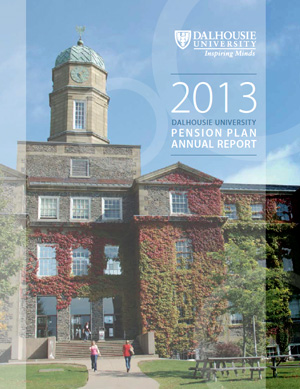Today@Dal
» Go to news mainIntroducing the Dalhousie Pension Plan Annual Report
For many (if not most) faculty and staff, the Dalhousie University Staff Pension Plan is an incredibly important part of retirement planning. It's something we all contribute to - and which we plan to benefit from at some point in our lives.
 To help better inform the Dal community about the plan, and to provide a detailed overview of its current financial status, the university has just released the inaugural edition of the Dalhousie Pension Plan Annual Report.
To help better inform the Dal community about the plan, and to provide a detailed overview of its current financial status, the university has just released the inaugural edition of the Dalhousie Pension Plan Annual Report.
The document is efficient (only 15 pages + appendices) and easy-to-read, defining key terms like “going-concern” and “solvency” while covering everything from the plan's governance model to its current investment performance. It also brings information about the plan's two funds — the Pension Trust Fund (which receives and invests contributions from the employee and the university while employed) and the Retirees Trust Fund (which issues pension payments to the retiree) — together into one convenient location.
Full report: Download the report from the HR's Pension website (under "Annual Report)
“It's about continuing to be open with our plan members, giving them information that's helpful in understanding one of their most important benefits as Dal faculty and staff,” says Katherine Frank, assistant vice-president of Human Resources.
“We know pensions aren't the simplest subject, but we've worked hard to continue to make pension communications more clear and reader-friendly,” adds Ian Nason, vice-president finance and administration (acting). “This report is another big step in that direction.”
Improvements and challenges
The pension plan has been a frequent topic of campus conversation in recent years, and the new Annual Report provides more context and the latest updates to help inform those conversations.
“There's some good news in the report relating to improvements in investment returns, which have helped to alleviate some pressure, but we still have a lot of work to do,” says Nason.
It's no secret that the plan is in deficit — according to the latest actuarial valuation on in March 2013, by about $84 million. The good news Nason speaks of is in regards to the plan's assets, which have substantially improved thanks to strong investment returns, increased employee contributions and special payments made by the university.
The problem is that liabilities — what the plan, over time, will owe to its members — are growing at a faster rate than assets, which is why the plan's deficit has increased. This growth in liabilities is due to a number of factors: low interest rates, increased life expectancies and an aging population.
These challenges are not unique or new to Dalhousie, but they are ones that the plan's sponsors, trustees and members will need to continue to work together on addressing.
“The pension plan is incredibly important to our community, and our collective goal is to ensure its success and sustainability,” says Nason. “The university administration, the Pension Advisory Committee and trustees will all continue to focus our efforts on ensuring the plan continues to support our community in the years ahead.”
The university welcomes feedback on the inaugural edition, which can be emailed to pensions@dal.ca.
“If there are still elements of the pension plan that our faculty and staff don't fully understand after reading the report, we want to hear from them so we can continue to improve the report in future years,” says Nason.
Full report: Download the report from the HR's Pension website (under "Annual Report)
